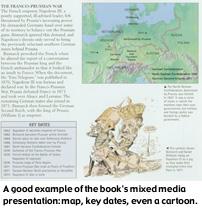Book Review: The Kingfisher Concise History Encyclopedia
|

|
| Reading Level |
|
Ages 9-12 |
|
Share This Page
|
|
|
|
|
|
|
Follow This Site

|
 |
|
|
|

|
The
single best historical encyclopedia on the market today for
young students is the Kingfisher Concise History
Encyclopedia. Filled with rich illustrations and plenty of
maps, timelines, and other graphics, it is also a wonderful
presentation of basic facts and cause-and-effect context.
This
richness of context is what sets it apart from others. By
presenting the stories of every continent in chronological
groups, the book gives the reader a sense of "This is all
happening at the same time." Studies of world history often
neglect this "whole world view."
Starting
at 40,000 B.C. and working its way up to the new millenium,
this book gives you a great overview and plenty of rich
context for a thorough understanding of the world's history
and future.
This
book also stands out because it focuses on more than just
politics and wars. Especially in the study of the last half
of the 20th Century, the reader learns about environmental
concerns, famine woes, the space race, the modern scientific
revolution, and other aspects of history that are often
overlooked in standard world history presentations.

Part of
the new Concise Encyclopedia series (which also includes the
Children's Encyclopedia, the Science Encyclopedia, and the
Encyclopedia of the Future), this book is vital to any
student's understanding of the history of the world.
Graphics
courtesy of Kingfisher